Arthur Szyk: FDR's 'Soldier in Art'
Posted by Mad Mitch on UTC 2016-08-29 19:13
Arthur Szyk (pron. 'Schick') (1894-1951) was born into a middle-class Jewish family in Łódź, Poland. He sensibly left Poland in 1937 and moved to the Britain, then to the USA in 1940. He became a US citizen in 1948.
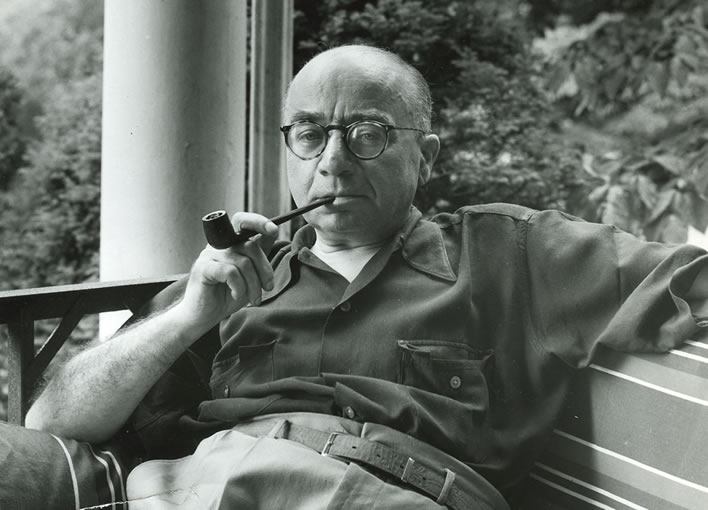
Arthur Szyk, c. 1946, on the porch of his home in New Canaan. Image: The Arthur Szyk Society, photographer unknown.
He was a skilled caricaturist, illuminator, illustrator and miniaturist with an immense capacity for work. He was grateful to his new homeland and produced many hundreds of patriotic illustrations and caricatures. During the war his work was enormously popular in the USA. He described himself as President Franklin D. Roosevelt's 'Soldier in Art'.
In 1942 he produced a large and complex caricature of the Allies' enemies which he entitled Satan Leads the Ball.
Overview

Full view of Satan Leads the Ball, by Arthur Szyk, 1942.


Left and right halves of Satan Leads the Ball.
Explorations
It's worth browsing around the image. The work is broadbrush political satire at its best, but even so, it contains a lot of interesting and carefully thought-out elements.

Brünnhilde and Satan.
Left: The caricature is of Brünnhilde, a key figure in Richard Wagner's opera cycle Der Ring des Nibelungen. Wagner was a rabid anti-semite and his works were a big hit with National Socialists. He beefed up the Brynhild/Brünhild of the original sagas, already quite a feisty girl, by tweaking her name to Brünnhilde, etymologically meaning 'armoured fighting woman'. The Nazis propagandised the role of the female in the state with organizations such as the Bund Deutscher Mädel (BDM), which was the female arm of the Hitlerjugend (HJ). It is therefore no surprise to see her here as standard-bearer of the gang, festooned with 'Heil Hitler' ribbons. Around the fringe of her robe (not shown in this detail) are the words Jude ver[r]eck, 'Jew, die!' a centuries old antisemitic curse.
Right: Our old friend Satan. Szyk has tellingly given his nicely realised image of the Devil a book titled Nibelungenring. There is a treble clef on the cover so presumably this is the music for the ball to which he is leading the group. The Nordic sagas, particularly as restated in easily – relatively easily – digestible form by Wagner, formed the basis of Nazi mythmaking, which was the intellectual undertow for the rest of the National Socialist ideological claptrap: the racial superiority, the idea of divine destiny and so on.
Many of the participants in the dance are wearing black-white-red sashes. Black-white-red had been the colours of the North German Confederation from 1866, then those of its successor the German Empire from 1871–1918. From 1919 the Weimar Republic distanced itself from its predecessor by adopting a black-red-gold colour scheme, which the National Socialist regime changed back to black-white-red almost immediately after taking power in 1933, a colour scheme which remained until the end of the war in 1945, when the modern German state returned to black-red-gold. With this prominent display of the colours of the German Empire and its Nazi successor, Szyk seems to be saying that not only individuals and personifications are at this ball, but also German politics and the German state since the mid-19th century.
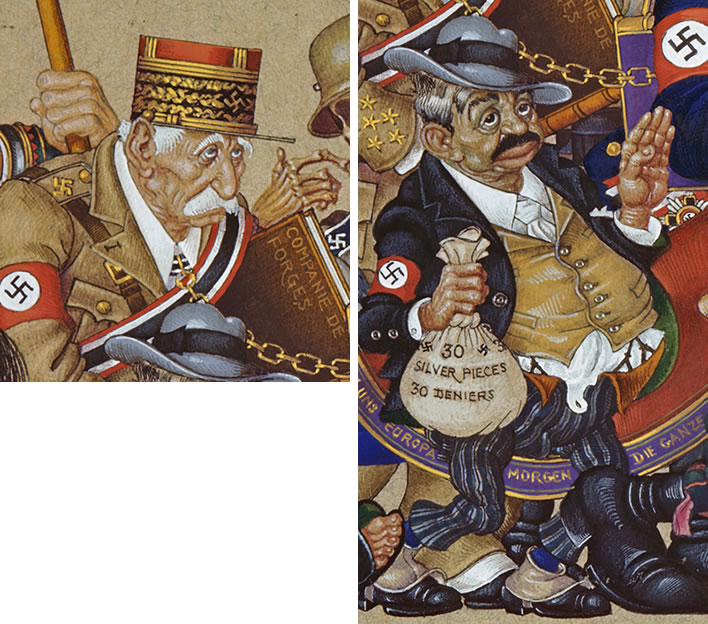
Pétain and Laval: two French collaborators.
Two French dancers. On the left, the decrepit Marshal Philippe Pétain (1856-1951), the 'hero of Verdun' in the First World War. He became the President of Vichy France in the Second World War and made an accommodation with the Nazis. The golden chain dangling from his neck binds him to Hermann Göring. The book he is carrying is entitled Companie de[sic] Forges, which should correctly be Comité des Forges, the immensely powerful group of French iron and steel producers formed in 1864, which created a monopolist cartel that lasted until 1940. The Comité des Forges was in fact dissolved in 1940 by the Vichy government and replaced with a state-run monopolistic cartel. Staying in French, we find an appropriate epigram: Plus ça change, plus c'est la même chose. Pétain spent his final years of his dotage in prison.
Pierre Laval (1883-1945) was the French politician who created the Vichy state and the puppetmaster who made Pétain President and ran the government. He was an enthusiastic collaborator with the Nazis, involved in enabling forced labour and deportation. The floppy hat, the white tie and the spats were particular features of his. After the war he was sentenced to death. On the day of his execution he tried to evade the firing squad by swallowing an ampoule of cyanide. The cyanide was past its use-by date (so French!) and he survived, only to be shot on the same day as soon as he was able to stand.
On the bag he is carrying is written '30 silver pieces', the reward paid to Judas Iscariot for his betrayal of Jesus. We are also given the name of the coins in French, deniers, silver pennies, related to the Roman coins denarius. The swastika on the bag tells us that it is Nazi money.

Reichsmarschall Göring and friend.
Hermann Göring (1893-1946) is here portrayed in his Reichsmarschall uniform with the blue Luftwaffe lapels. Under his arm is a book titled Hermann-Göring-Werke, which denotes the industrial conglomerate Reichswerke Hermann Göring. The golden chain from this book leads to the collar of Pétain, who is also carrying a book titled after a French conglomerate, the Comité des forges.
The crazed look on Göring's face was a speciality of Szyk's illustrations of him. Göring's splendid uniform contrasts well with the skeleton wearing a drab generic German army uniform that is following him. Szyk shows Göring, the WWI fighter ace, also wearing his order Pour le Mérite (military class), which he was awarded in 1918.
Unlike Laval, Göring successfully evaded the executioner with cyanide – the Nazi top-brass always kept the best stuff for themselves, whether artworks or poison.
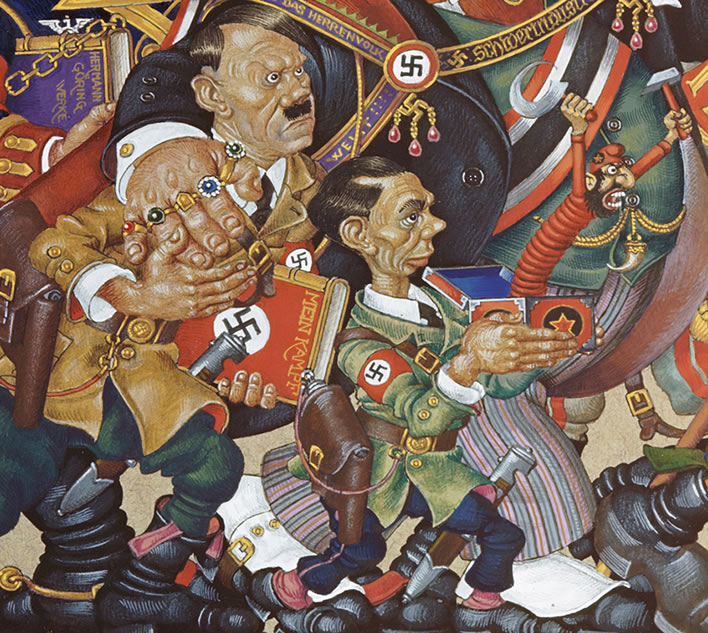
Adolf Hitler and Josef Goebbels.
Adolf Hitler (1889-1945) and his book Mein Kampf, 'My Struggle' need no introduction.
Joseph Goebbels (1897-1945) was 'Minister for Public Enlightenment and Propaganda' from 1933 to 1945. This title is another of the many reasons why we on this blog become uneasy when moderns start shouting about 'Enlightenment'.
The jack-in-the-box he is carrying is designed to make everyone jump in fright when it opens and a caricature Jew waving the Bolshevik hammer and sickle pops out. The already disturbing mixed symbolism reaches its climax when we note that the Jew is wearing the red 'Phrygian cap' that became the symbolic headwear of the French Revolution. On the cap and the box we see the five-pointed red star of the Russian Revolution. In other words, the two great bogymen for the Nazis in one box: the Jews and the Bolsheviks.
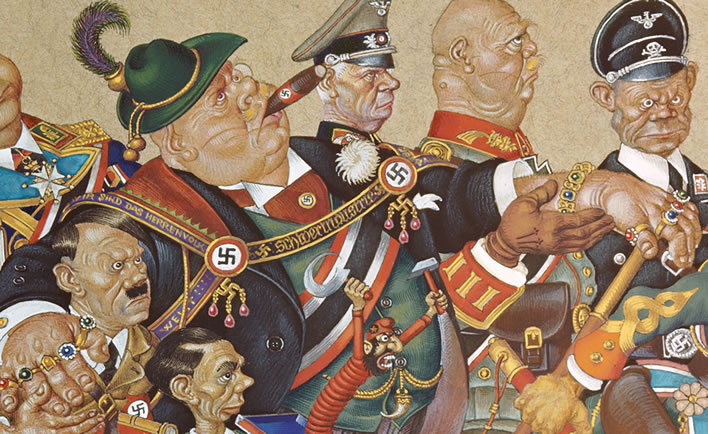
A German heavy industrialist, in every sense.
The centrepiece of the composition is the bloated industrialist, which, given what we have seen with the books carried by Pétain and Göring, should not surprise us. The halter around his shoulders bears the text Wir sind das Herrenvolk, 'we are the ruling people' and, on a ribbon that reaches right back through Mussolini's hands Heute …gehört uns Europa, Morgen die ganze…Welt at the side and across the front Schwerindustrie, 'heavy industry'. The face is marked with two duelling scars, a reminder of the time in the student associations that contributed to the maintenance of a German elite. There is a National Socialist party pin in his cravat. He is fat, decorated with swastikas and laden with bejewelled rings. His righthand rests protectively around Hitler, the army General (also with duelling scars) at his side supports his left arm.
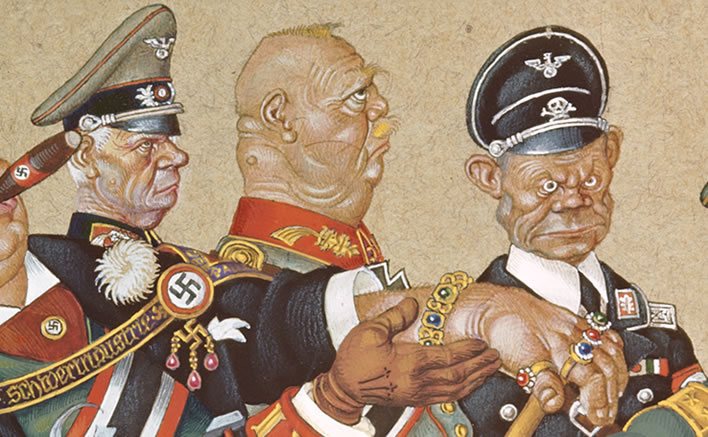
Three military men.
There are three military men in the background behind the industrialist. On the left, Erwin Rommel (1891-1944), the 'Desert Fox', was at the peak of his reputation in 1942 at the time Szyk was creating this picture and was a personification of the fighting German army officer.
The figure on the right seems to be that of SS General Matthias Kleinheisterkamp (1893-1945). He was in command of a unit of the SS during the invasion of Poland and was for a time a commander of the SS Totenkopf 'Death's Head' division in France. In both cases he would have been a person of interest to the Polish emigrant Szyk. Szyk has caught the pitiless stare of the SS man well. The figure is definitely not Heinrich Himmler, the leader of the SS: Szyk had caricatured him in other works and was perfectly capable of rendering his wire-rimmed spectacles and Hitler-style moustache.
The figure in the middle is more problematical. From its appearance it might be Erich Ludendorff, except that he had a chequered history with the Nazis. It is certainly not Paul von Hindenburg. Not knowing, at least for the moment, whether this figure is of a particular person, we can leave it as a personification of the role of the High Command of the German military in the support of the Nazi state – in fact, a component of what we now call the military-industrial complex.
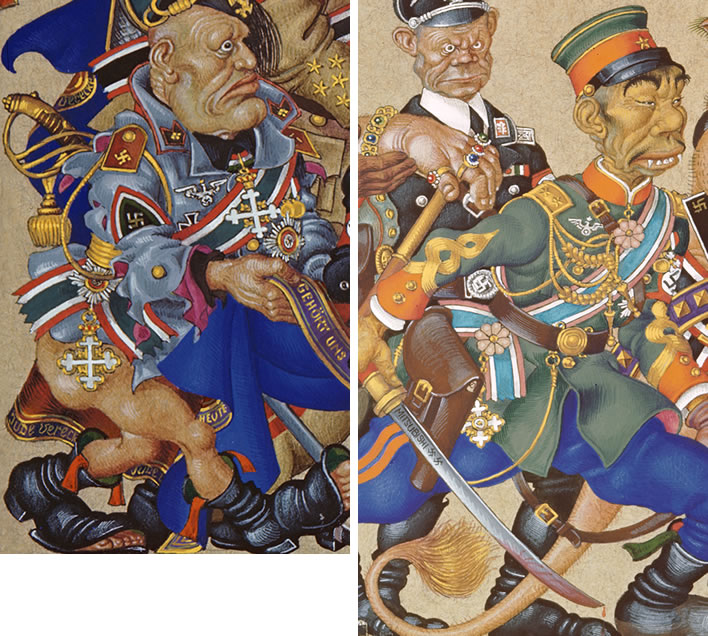
Benito Mussolini and Emperor Hirohito(?)
Szyk's caricature of Benito Mussolini (1883-1945) is part of a group representing the servile states, Italy and Vichy France. Depicting him without his trousers and with his toes poking out of his boots is good knockabout fun but the artist takes some other liberties with the truth. Mussolini would never have worn the swastika, a German symbol that was not part of the Italian Fascist iconography. He is, accurately, wearing a sash in the green-white-red colours of the Partito Nazionale Fascista (PNF), the Italian fascist party.
Mussolini's uniforms, here ridiculously over decorated, were usually quite restrained. He did dress up on occasion, but generally he preferred his 'man of the people' look. The two extremely large (Savoy) crosses that Szyk has chosen to show so prominently are two (!) specimens of the insignia of a Commander of the Order of Saints Maurice and Lazarus. Unfortunately, Szyk didn't show him wearing the collar badge and plaque of a Knight of the Supreme Order of the Most Holy Annunciation, which the King of Italy had given him in 1924, the highest order that could be given to an Italian. Now that really was bling: walk into an Italian restaurant wearing that and the food and service will be superb. So will the bill. And the tip.
To the caricature Japanese figure I can put no name. It might be a pastiche of the Emperor Hirohito (1901-1989), but the confused and confusing iconography means that we cannot be certain. It may just be a generic personification of Japanese militarism. Does it matter? Probably not.
For example, the Imperial Seal of Japan, a.k.a the Chrysanthemum Seal, reserved for Emperors, is hinted at twice, but should have 16, not eight petals.
The caricature is also wearing the insignia of the Commander of the Order of Saints Maurice and Lazarus, in common with Mussolini. It may be that Szyk, the Polish Jew, is here making hay against the old enemy in Poland, the Catholic Church, which was responsible for much Jewish suffering in Poland long before the Nazis got involved.
As also in the case of Mussolini, it is incredible that a Japanese figure should wear the Nazi swastika: the Japanese would view the swastika as a Buddhist symbol representing eternity (albeit 'rotating' in the opposite direction). One clear image is given, though: the bloody Samurai sword engaved with the name 'Mitsubishi' (and two swastikas) – once again an allusion to the role of industrial conglomerates and heavy industry as part of the military-industrial complex in fomenting war.
The end of the dance
Throughout the war years and after, Szyk worked on patriotic and cultural projects and illustrated books. He became one of the most loved and popular illustrators of his generation, a major figure in an era that is regarded as being the Golden Age of American illustration art. He produced wonderfully detailed illuminated versions of documents such as the Declaration of Independence– in fact, all his work is suffused by patriotism and equal respect for the Jewish and Christian cultural traditions.
No good deed goes unpunished. In 1951, Szyk's name managed to land on a list for the Un-American Activities Committee of the House of Representatives. We may chortle at the absurdity of a man who had spent the previous ten years working so diligently for the American war effort and in support of the 'American Dream' now being accused of communist affiliations and 'un-American' activities, but the danger for Szyk himself and the threat to the future of his work was very real. After some administrative tussles he convinced them of his innocence. The relief didn't last: Arthur Szyk died shortly after he was cleared, on 13 September 1951, of a heart attack, his third.
The work of illustrators who create gentle or pointed commentary on contemporary life such as Norman Rockwell lives on, deservedly undiminished. For some reason Arthur Szyk's work and reputation faded quickly after his death. It did not help that he died at the young age of 57 and missed the transition to the new age in America. Perhaps Szyk's brand of simple and enthusiastic patriotism became unpopular in the complex decades that followed the 1940s.
As we have seen in the case of Satan Leads the Ball, the iconography of his work is not at all obvious to modern generations. Recovering that work and reputation is not easy: the work of illustrators may be reproduced in millions of copies, but after a very short while those millions become a dog-eared few. The original has to survive, be curated, made accessible and published. I have no idea who, if anyone, is sitting on Szyk's originals where they still exist.
0 Comments UTC Loaded:
Input rules for comments: No HTML, no images. Comments can be nested to a depth of eight. Surround a long quotation with curly braces: {blockquote}. Well-formed URLs will be rendered as links automatically. Do not click on links unless you are confident that they are safe. You have been warned!